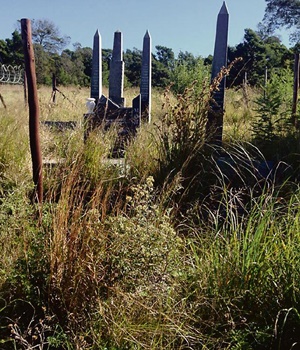
In 2005, I wrote several newspaper articles about the disgraceful state of the graves of Xhosa poet SEK Mqhayi and ANC founder Walter Rubusana, and the home of academic and politician Davidson Don Tengo “DDT” Jabavu.
That was a decade ago. So, on a recent visit to the Eastern Cape, I thought I would make a turn at these places again to look at their current condition. Given the outrage that was expressed at the time, I thought the graves would be in mint condition and might even have been declared national heritage sites.
I started with Mqhayi’s grave in Ntabozuko, just outside the still incongruously named town of Berlin.
Mqhayi first gained fame as Imbongi yakwa Gompo (The Poet of Gompo, AKA East London). His national profile rose fast enough for DDT Jabavu to pronounce him i-Mbongi ye Sizwe Jikelele (the poet laureate of the nation). I recently discovered a letter in which Mqhayi responds to a compliment from a Mrs Stormont: “You say that I am ‘a great man now with a great influence over my people’. I think this is quite true, though I am so shy; yet people think very highly of me, not only the enlightened ones, but chiefs and raw natives in the Ciskei and Transkei, the Transvaal and Free State.”
Mqhayi’s national significance was owed primarily to his literary genius. In 1914, he wrote the first novel in isiXhosa, Ityala Lamawele, the earliest literary expression of the notion of justice as reconciliation.
His 1929 novel, U-Don Jadu, was a fictional representation of a free and democratic society, with equal rights for men and women. A little-known fact is that Mqhayi wrote most verses of our national anthem. Although Enoch Sontonga had composed the song as a hymn with two stanzas, Mqhayi added seven more and published it as a poem titled Umhobe we Sizwe (The National Anthem) in 1927. It went on to become the national anthem of Tanzania, Zambia, Zimbabwe and Namibia.
Mqhayi wrote biographies of eminent Africans such as Rubusana and John Langalibalele Dube. He also wrote his autobiography, Umqhayi wase-Ntabozuko. In Long Walk to Freedom, Nelson Mandela writes that the day of Mqhayi’s visit to his school at Healdtown was declared a public holiday.
Historian Colin Bundy describes how Fort Hare students such as Govan and Epainette Mbeki (née Moerane) and Phyllis Ntantala regularly went to learn at the great man’s feet in Ntabozuko.
In his last book, The Trouble with Nigeria, Chinua Achebe lists Mqhayi alongside Amos Tutuola in the history of Africa’s greatest writers.
In 2003, I invited Ngugi wa Thiong’o to deliver the Steve Biko Memorial Lecture at the University of Cape Town. The Kenyan dedicated his lecture to Mqhayi. It was a stellar performance, even by Ngugi’s worldly wise standards. I recently received an email from him about that event: “It is amazing how people still talk about that Biko lecture,” he wrote.
And yet the body of this giant of African literature lies in a virtual rubbish dump, in worse condition than when I first raised a stink about it in 2005.
For a long time, I thought there was nothing the ANC government could do further to hurt my feelings – until I saw the sacrilegious state of Mqhayi’s grave.
Other countries treat people like Mqhayi as their founding spirits, whether it is Gabriel García Márquez in Colombia, Pablo Neruda in Chile or Walt Whitman in the US.
Although the ANC does not generally care about the leaders of other liberation movements, it always takes care of its own. So I assumed Rubusana’s grave would have been restored. He was the founding president of the SA Native Congress in 1890, which organised the SA Native Convention in 1909, which transmuted into the SA Native National Congress in 1912 and the African National Congress in 1923. He was the author of the classic Zemk’ Inkomo Magwalandini, and was the first and last black parliamentarian before black people were removed from the voters’ roll in 1936.
I could not remember the grave’s exact location in the also incongruously named East London.
There was nothing to show that such a historical figure lay buried in the neighbourhood. My enquiries were met with blank stares and head-shaking. A drunk passer-by sarcastically suggested I might want to have my head checked.
I finally found the grave of the founding father of the congress movement being used as a driving school yard on the city’s back streets of Braelyn. The grass was as overgrown as it had been 10 years go. Imagine the grave of George Washington or Mahatma Gandhi being used like this in their countries and tell me we have not lost our minds.
I then drove to the former home of DDT Jabavu in Middledrift. He was the son of the legendary John Tengo Jabavu, founder of the first black-owned newspaper, Imvo Zabantsundu, and a man who pushed for the establishment of Fort Hare. After looking aimlessly for the older Jabavu’s grave in the King William’s Town cemetery, I drove to his son’s home in Middledrift.
DDT was the first black professor in South Africa and the founding president of the All African Convention. He was also the first vice-president of the SA Institute of Race Relations and received an honorary doctorate from Rhodes University in 1967.
His stature was such that he was received by heads of state like India’s celebrated Jawaharlal Nehru when he travelled abroad.
There was signage to the Jabavu House, which gave me some hope. But I soon discovered it was the signage to a hellhole. I found the roof falling in.
One of DDT’s surviving daughters had put a bucket under the leaking ceiling to trap the water. She told me one of Jabavu’s colleagues from Oxford had popped in for a visit, but had turned back in disgust.
I was met with one answer everywhere I turned for an explanation for the neglect. “There is no government here.” No wonder the ANC lost to the DA at Fort Hare. If you cannot take care of the graves of your own founders, how can you take care of anything else?
To make the point, someone handed me a poem by Welile Shasha titled Zihlabana Nje Ziyalamba. I read: Bayahlutha abazisengayo, Basengel’eselweni nase mlonyeni [Those who milk the cows do so to the bucket pail and to their mouths].
What broke my heart was that the people still thought the national government could still do better 10 years on. Really? Ten years later?
I now make this appeal to the students of the #RhodesMustFall movement and their colleagues around the country: rebuild graves in every part of South Africa. Each grave has a story to tell. Bring those stories back into the classroom so we can construct a new curriculum. Bring your fellow white students along, so we can all build a new consciousness for our country.
As Frantz Fanon once said: Every generation has to discover its own mission.
Biko and his fellow students showed that this discovery began through raising consciousness. Students, your turn to lead is now.
Mangcu is an associate professor at the University of Cape Town and an author




 Publications
Publications
 Partners
Partners








